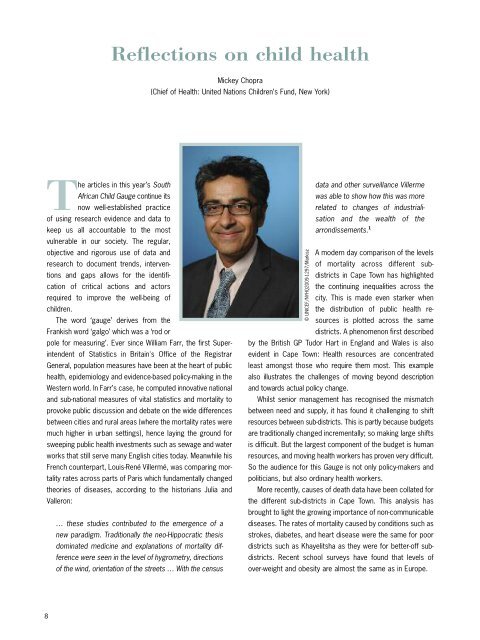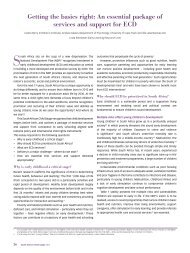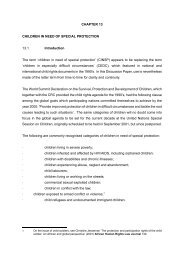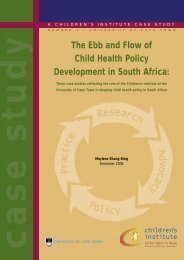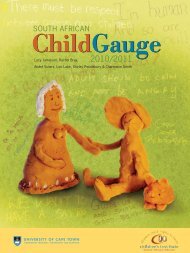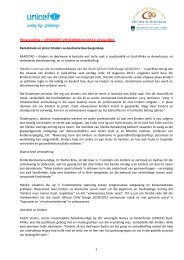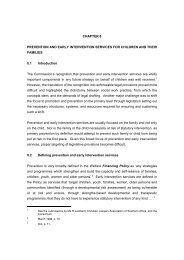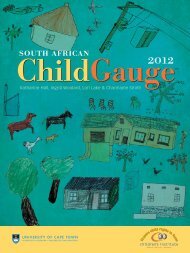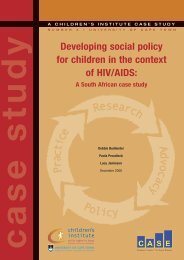South African Child Gauge 2009/2010 - Children's Institute
South African Child Gauge 2009/2010 - Children's Institute
South African Child Gauge 2009/2010 - Children's Institute
Create successful ePaper yourself
Turn your PDF publications into a flip-book with our unique Google optimized e-Paper software.
Reflections on child health<br />
Mickey Chopra<br />
(Chief of Health: United Nations <strong>Child</strong>ren’s Fund, New York)<br />
The articles in this year’s <strong>South</strong><br />
<strong>African</strong> <strong>Child</strong> <strong>Gauge</strong> continue its<br />
now well-established practice<br />
of using research evidence and data to<br />
keep us all accountable to the most<br />
vulnerable in our society. The regular,<br />
objective and rigorous use of data and<br />
research to document trends, interventions<br />
and gaps allows for the identification<br />
of critical actions and actors<br />
required to improve the well-being of<br />
children.<br />
The word ‘gauge’ derives from the<br />
Frankish word ‘galgo’ which was a ‘rod or<br />
pole for measuring’. Ever since William Farr, the first Superintendent<br />
of Statistics in Britain's Office of the Registrar<br />
General, population measures have been at the heart of public<br />
health, epidemiology and evidence-based policy-making in the<br />
Western world. In Farr’s case, he computed innovative national<br />
and sub-national measures of vital statistics and mortality to<br />
provoke public discussion and debate on the wide differences<br />
between cities and rural areas (where the mortality rates were<br />
much higher in urban settings), hence laying the ground for<br />
sweeping public health investments such as sewage and water<br />
works that still serve many English cities today. Meanwhile his<br />
French counterpart, Louis-René Villermé, was comparing mortality<br />
rates across parts of Paris which fundamentally changed<br />
theories of diseases, according to the historians Julia and<br />
Valleron:<br />
… these studies contributed to the emergence of a<br />
new paradigm. Traditionally the neo-Hippocratic thesis<br />
dominated medicine and explanations of mortality difference<br />
were seen in the level of hygrometry, directions<br />
of the wind, orientation of the streets … With the census<br />
© UNICEF/NYHQ<strong>2009</strong>-1297/Markisz<br />
data and other surveillance Villerme<br />
was able to show how this was more<br />
related to changes of industrialisation<br />
and the wealth of the<br />
arrondissements. 1<br />
A modern day comparison of the levels<br />
of mortality across different subdistricts<br />
in Cape Town has highlighted<br />
the continuing inequalities across the<br />
city. This is made even starker when<br />
the distribution of public health resources<br />
is plotted across the same<br />
districts. A phenomenon first described<br />
by the British GP Tudor Hart in England and Wales is also<br />
evident in Cape Town: Health resources are concentrated<br />
least amongst those who require them most. This example<br />
also illustrates the challenges of moving beyond description<br />
and towards actual policy change.<br />
Whilst senior management has recognised the mismatch<br />
between need and supply, it has found it challenging to shift<br />
resources between sub-districts. This is partly because budgets<br />
are traditionally changed incrementally; so making large shifts<br />
is difficult. But the largest component of the budget is human<br />
resources, and moving health workers has proven very difficult.<br />
So the audience for this <strong>Gauge</strong> is not only policy-makers and<br />
politicians, but also ordinary health workers.<br />
More recently, causes of death data have been collated for<br />
the different sub-districts in Cape Town. This analysis has<br />
brought to light the growing importance of non-communicable<br />
diseases. The rates of mortality caused by conditions such as<br />
strokes, diabetes, and heart disease were the same for poor<br />
districts such as Khayelitsha as they were for better-off subdistricts.<br />
Recent school surveys have found that levels of<br />
over-weight and obesity are almost the same as in Europe.<br />
8


